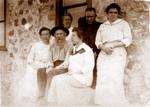 |
|||||||||||||||
|
|||||||||||||||
Thomas Long |
|||||||||||||||
|
"...never forget what they did here. It is for us the living, rather, to be dedicated here to the unfinished work which they who fought here have thus far so nobly advanced...-- Abraham Lincoln 1863 |
|||||||||||||||
|
Thomas Long was born on May 22, 1838 in Fairfield County, Ohio according to his application for a Civil War pension. His father was John H. Long and his mother was Sarah Ann LeFevre. John was 5 feet 10 inches and had a dark complexion, black eyes and dark hair. He joined the Union Army on September 8, 1861 as a private in Captain Frank Fisk's Company H of the 4th Illinois Cavalry which was made up of volunteers from Logan and Tazewell Counties. On September 26, 1861, the Regiment was mustered into service and marched to Springfield and to receive arms and then marched south to Cairo, Illinois. Thomas drove a wagon from September 27, 1861 to June 1, 1863. It was noted in August, 1862 that he owned his own horse and equipment. In December 1861 the regiment was the advance body of a march east to Columbus. At Milburn, Illinois, Company H was selected to carry dispatches a few miles east to Mayfield to General C. F. Smith. Thomas was in Ottawa, Illinois from February 5 to February 7, 1862 and Thomas suffered from catarrah. They returned their old quarters in Cairo and stayed there until ordered to Fort Henry in Eastern Tennessee. They went by steamer as far as Parsons' Ferry and then by land to Panther Island where they were ordered to to drive in the rebel pickets in advance of General McClernand's Division. Immediately following the surrender of Fort Donelson the regiment moved to Randolph Forges where it remained until ordered back to the Tennessee River, opposite the mouth of the Sandy. The regiment was again loaded on steamers and went to Pittsburg Landing, Tennessee where they participated in the battle of Shiloh which was April 6th and 7th in 1862. They camped on the bluff. They were assigned to a brigade command by Brigadier General Louman. Company H was assigned to General Sherman. They moved to the front on Saturday and camped to the left of the old church near the Fifty-third Ohio Infantry. On the morning of the 6th, while eating breakfast, under a shower of bullets, the regiment was ordered to mount at once and report to General Sherman. After the battle of Shiloh the Fourth scouted the front and led a raid upon Purdy and the railroad, capturing a train, destroying a considerable amount of track and several bridges. During the Seige of Corinth, Mississippi from April 29 to May 30, 1862, the part of the regiment under Sherman advanced on the right, and continued until the explosion of ammunition in Corinth convinced General Halleck that Beauregard had succeeded in withdrawing his entire army. After entering Corinth, still in front of Sherman, the Regiment was slowly sent towards the west, finally reaching Memphis, Tennessee in August, 1862. Thomas suffered from dysentery from July 24 to August 9, 1862. They moved from Corinth in September, 1862 to Trenton, on the line of the Mobile and Ohio Railroad where they scouted the line. They remained until the movement down the line of that road and the Mississippi Central began, when, under Colonel Lee, of the Seventh Kansas, commanding a Brigade of Cavalry, it struck Vandorn and Price near Holly Springs, and followed them to near Coffeeville, where it lost Lieutenant Colonel McCullough in a night fight, and fell back to Water Valley, and with the withdrawal of General Grant back to the line of the Memphis and Charleston road, Moscow and Collierville. After staying at Bolivar about three weeks, the Regiment returned to its headquarters, then stationed at Collierville, where it remained until August, 1863, when it was ordered to Vicksburg, where the Regiment was united. After staying a few days at Vicksburg. From Vicksburg the Regiment was sent to Natchez, in the winter of 1863-4. Thomas was promoted to corporal on May 1, 1864. He was later promoted to sergeant. He transferred to Company M of the 12th Illinois Cavalry. He was honorably discharged on January 3, 1864 at Natchez, Mississippi. He reenlisted January 4, 1864. He served as sergeant in Company M under Lieutenant Charles H. Busson in the Illinois Veteran Cavalry Volunteers. He was on furlough from March 18, 1864 to April 30, 1864. He transferred to company E in the consolidation on October 17, 1864. He was again honorably discharged May 29, 1866 at Houston, Texas. He married Louisa Taylor on March 28, 1868. Their family and life together are described in detail in the section on Thomas and Louisa Long.
According to his pension application, he began to suffer from heart trouble in 1877 and that it was not due to "any vicious habits." He became a widower when Louisa died on April 12, 1911. He died of heart failure on June 21, 1917 near Kintyre, North Dakota. He is buried in Napoleon Cemetery in Logan County, North Dakota with his wife and daughter Viola.
|
|
|||||||||||||
|
|||||||||||||||
|
|
||||||||||||||
|
|||||||||||||||
|
©Roberta Tuller 2019
| |||||||||||||||


